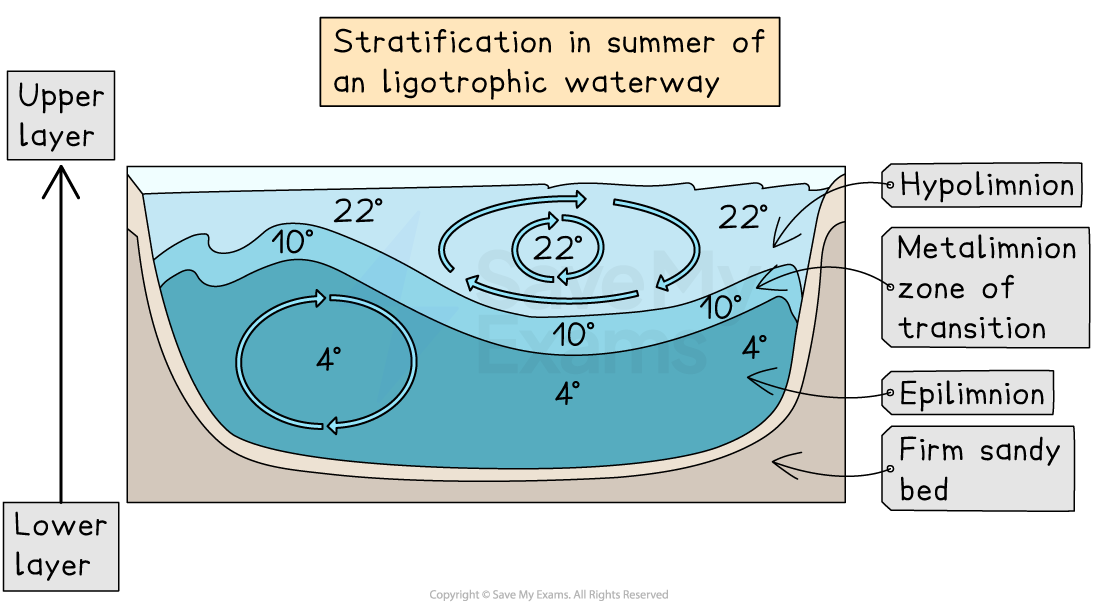Eutrophication (College Board AP® Environmental Science): Study Guide
What is eutrophication?
Eutrophication occurs when a body of water is enriched in nutrients, typically nitrates and phosphates
This usually results in the excessive growth of phytoplankton, a type of microscopic algae, as well as aquatic plants
There are two types of eutrophication
Natural eutrophication, which is a slow, organic process occurring due to the build-up of sediment and nutrient enrichment
Cultural or anthropogenic eutrophication, however, is a fast, human-induced water pollution typically caused through:
agricultural run-off
detergents and sewage that are discharged into waterways without proper treatment
nitrogen from animal breeding and fuel combustion
Examiner Tips and Tricks
Don't confuse natural eutrophication with cultural eutrophication. Cultural eutrophication is a fast-acting pollution caused by human activities.
Methods of reducing cultural eutrophication
The aim should be to reduce nutrient inputs from point and non-point sources , particularly phosphorus and nitrogen
Methods include:
improving sewage treatment to remove phosphorous and nitrogen
reducing fertilizer use to minimize nutrient runoff
recycling animal manure to reduce nutrient leaching
riparian buffer strips
improving wetlands as they act as natural filters
public awareness and education to reduce consumption of protein-rich foods
The process of eutrophication
The process of eutrophication occurs in stages
Nutrient enrichment from excess nitrates and phosphates enters the water and increases phytoplankton, algae, and aquatic plant growth
This causes dense aquatic plant growth to occur near the surface that blocks sunlight reaching underwater plants
An algal bloom forms that quickly uses available nutrients and eventually, the bloom completely covers the water's surface
Aquatic plants below the water surface begin to die as they are unable to photosynthesize
As photosynthesis helps to oxygenate the water, dissolved oxygen levels begin to decrease
When competition for nutrients becomes too intense, the algae, phytoplankton and plants begin to die
The decay of phytoplankton and plants leads to further oxygen depletion because
decomposing bacteria respire aerobically, using up the already depleted dissolved oxygen in the water
aquatic organisms such as fish and insects are then unable to survive, resulting in large die-offs
Stages of eutrophication

Hypoxic waterways
Hypoxic waterways are those bodies of water that are low in dissolved oxygen
Caused through:
excess nutrients forming algal blooms and depleting dissolved oxygen
the breakdown of organic matter like sticks, grass, and crops by bacteria, particularly following floods
water stratification due to temperature or salinity variations can cause hypoxia
The effects of hypoxia are
large-scale die-off within the waters
illness from eating shellfish poisoned by harmful algal blooms
on-shore death of marine mammals and birds from eating the algal bloom
the lack of aquatic life in hypoxic environments causes 'dead zones'
Estuaries, coastal waterways, lakes, rivers, and streams can become hypoxic
Chesapeake Bay, Lake Erie, the Gulf of Mexico, and Long Island Sound are all hypoxic
Oligotrophic waterways
Oligotrophic waters are usually seen in upland areas with hard, acid rocks
Compared to eutrophic waterways, oligotrophic water has
very clear, deep and cold water
firm sandy beds
low nutrient concentrations
stable algae populations
high levels of dissolved oxygen
low numbers of aquatic organisms
Lake Superior is considered the most oligotrophic lake in the world, although it still has enough nutrients for plants and animals to survive
Oligotrophic waters tend to stratify into three layers in summer, with the highest temperatures in the first 5–24 meters of water due to warming by the sun
Within in the upper layer, the epilimnion, water is mixed by wind and wave movement
Photosynthesis and atmospheric diffusion keep dissolved oxygen levels high in summer
The metalimnion or thermocline, acts as a temperature barrier
This prevents mixing and heat exchange between the layers
The hypolimnion is the lowest and coldest
Organisms rely on detrital fallout from the epilimnion and oxygen levels are quickly used
Oxygen is replenished when thermal stratification breaks down and the water mixes again
This is called ‘overturn’ and occurs in autumn or winter

Anthropogenic causes of eutrophication
Humans increase the rate and incidence of eutrophication by releasing high levels of nitrogen and phosphorus into nature
These levels occur from:
Rain washing fertilizers from farms, lawns, and golf courses into rivers and lakes
Wastewater from sewage treatment plants can cause nutrient contamination
Waste from industry
Burning fossil fuels
Aquaculture
Livestock rearing
Transporting livestock feed and manure can release excess nutrients
In developing countries, untreated sewage and industrial wastewater are the main cause of eutrophication
Typically, sewage facilities and manufacturers are less regulated; therefore, wastewater is discharged directly into waterways

Unlock more, it's free!
Did this page help you?